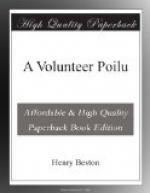At Dieulouard I had entered the shell zone; at Pont-a-Mousson, I crossed the borders of the zone of quiet; at Montauville began the last zone—the zone of invisibility and violence. Civilian life ended at the western end of the village street with the abruptness of a man brought face to face with a high wall. Beyond the village a road was seen climbing the grassy slope of Puvenelle, to disappear as it neared the summit of the ridge in a brown wood. It was just an ordinary hill road of Lorraine, but the fact that it was the direct road to the trenches invested this climbing, winding, silent length with extraordinary character. The gate of the zone of violence, every foot of it bore some scar of the war, now trivial, now gigantic—always awesome in the power and volition it revealed. One passed from the sight of a brown puddle, scooped in the surface of the street by an exploding shell, to a view of a magnificent ash tree splintered by some projectile. It is a very rare thing to see a sinister landscape, but this whole road was sinister. I used to discuss this sinister quality with a distinguished French artist who as a poilu was the infirmier, or medical service man, attached to a squad of engineers working in a quarry frequently shelled. In this frightful place we discussed la qualite du sinistre dans l’art (the sinister in art) as calmly as if we were two Parisian critics sitting on the benches of the Luxembourg Gardens. As the road advanced into the wood, there was hardly a wayside tree that had not been struck by a shell. Branches hung dead from trees, twigs had been lopped off by stray fragments, great trunks were split apart as if by lightning. “Nature as Nature is never sinister,” said the artist; “it is when there is a disturbance of the relations between Nature and human life that you have the sinister. Have you ever seen the villages beyond Ravenna overwhelmed by the bogs? There you see the sinister. Here Man is making Nature unlivable for Man.” He stroked his fine silky beard meditatively—“This will all end when the peasants plant again.” As we talked, a shell, intended for the batteries behind, burst high above us.
Skirting the ravine, now wooded, between Puvenelle and the Bois-le-Pretre, the road continued westward till it emerged upon the high plateau of La Woevre; the last kilometre being in full view of the Germans entrenched on the ridge across the rapidly narrowing, rising ravine. Along this visible space the trees and bushes by the roadside were matted by shell fire into an inextricable confusion of destruction, and through the wisps and splinters of this ruin was seen the ridge of the Bois-le-Pretre rapidly attaining the level of the moor. At length the forest of Puvenelle, the ravine, and the Bois-le-Pretre ended together in a rolling sweep of furzy fields cut off to the west and north by a vast billow of the moor which, like the rim of a saucer, closed the wide horizon. Continuing straight ahead, the Puvenelle road mounted




